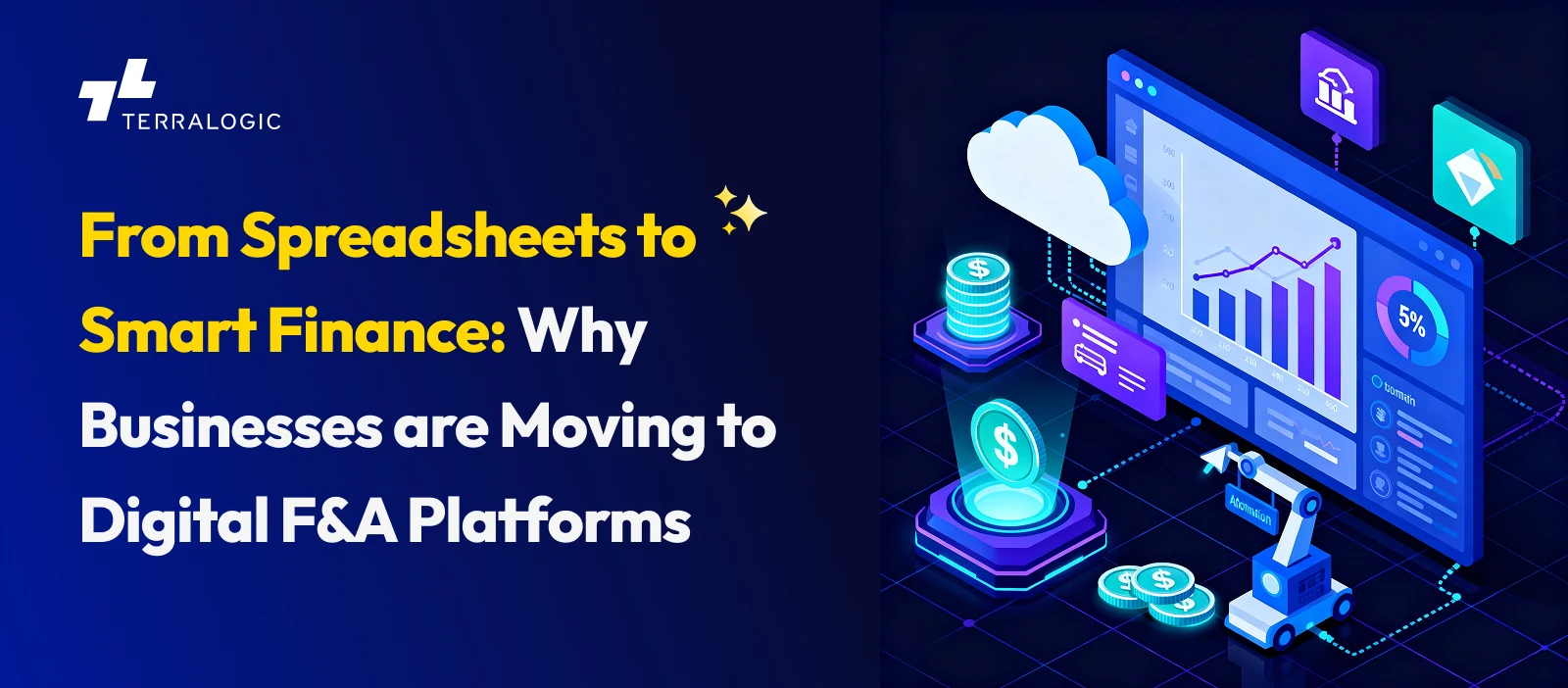From Spreadsheets to Smart Finance: Why Businesses are Moving to Digital F&A Platforms
October 14, 2025

When was the last time a critical business decision was trusted to a spreadsheet known to contain errors? For many, it was likely just last week or even yesterday.
Brilliant entrepreneurs often make million-dollar decisions based on Excel files held together by complex formulas, hope, and extensive manual data entry. Spreadsheets feel safe and familiar because you can see everything, but relying on them in 2025 is no longer just behind the curve—it actively handicaps business growth.
The smartest companies have already transitioned to digital finance and accounting platforms. This shift isn’t driven by a passion for technology or early adoption but by a critical realization: digital finance automation is now essential for survival.
While hours are still spent reconciling accounts and chasing data inconsistencies, competitors gain real-time insights, automate compliance, and leverage predictive analytics to move faster and smarter.
The shift to intelligent finance solutions is not coming—it is here. Companies adopting these tools first will gain a decisive competitive edge.
Let’s explore why this transformation is vital.
The Spreadsheet Problem: Why It’s Holding Businesses Back
Let’s start with an uncomfortable conversation about your current finance setup.
I’ll bet money that somewhere in your organization, there’s a “master spreadsheet” that everyone’s terrified to touch. You know the one – it’s got 47 tabs, formulas that reference cells from three different workbooks, and at least one circular reference that nobody understands but somehow makes everything work.
Sound familiar?
Here’s what that spreadsheet is actually costing you:
The Error Factor Research shows that 88% of spreadsheets contain at least one error. Not typos – actual mathematical errors that impact your financial reporting. I’ve seen companies make hiring decisions based on cash flow projections that were off by six figures because someone accidentally deleted a formula.
When we talk about spreadsheets vs finance automation, the error rate alone should end the conversation. Error-prone financial reporting isn’t just inconvenient – it’s dangerous.
The Time Sink Your finance team is spending 40-60% of their time on data entry and manipulation instead of analysis. Think about that for a second. You’re paying skilled professionals to be data entry clerks.
I know a CFO who spends the first week of every month just getting the numbers to “tie out” across different spreadsheets. That’s 25% of his month gone before he can even start providing strategic insights.
The Scalability Wall Here’s where it gets really painful. Spreadsheets don’t scale. At all.
When you’re a $2M company, managing finances in Excel is doable (though not optimal). But try running a $20M business with multiple locations, various revenue streams, and complex operational metrics on spreadsheets.
The companies I work with hit what I call the “spreadsheet wall” around $5-10M in revenue. Everything that worked before suddenly becomes a bottleneck. Month-end closes take forever. Financial reporting becomes a nightmare. Strategic planning turns into guesswork.
The Real-Time Problem Your spreadsheet shows you where you’ve been, not where you’re going. In today’s fast-moving business environment, historical data isn’t enough. You need real-time insights to make smart decisions.
By the time you update your spreadsheet, reconcile everything, and generate reports, the market conditions that informed those numbers have already changed.
That’s not digital accounting – that’s digital archaeology.
The Rise of Digital F&A Platforms
Okay, so what’s the alternative?
Digital F&A platforms aren’t just “better spreadsheets.” They’re completely different beasts that fundamentally change how finance operations work.
Think of it this way: if spreadsheets are like having a really good calculator, digital platforms are like having a entire finance team that never sleeps, never makes errors, and gets smarter every day.
Here’s what makes automated accounting platforms different:
They’re Connected Instead of isolated spreadsheets that need to be manually updated, digital platforms integrate with your bank accounts, payment processors, payroll systems, and business applications. Data flows automatically from source systems into your financial reporting.
They’re Intelligent Modern finance tools use machine learning to categorize transactions, detect anomalies, and even predict cash flow patterns. They’re not just processing data – they’re understanding it.
They’re Collaborative Multiple team members can work in the system simultaneously without version control nightmares. Your controller in Chicago and your CFO in New York are looking at the same real-time data, not different versions of the same spreadsheet.
They’re Scalable Whether you’re processing 100 transactions a month or 100,000, the platform handles it the same way. No more rebuilding your entire finance infrastructure every time you hit a growth milestone.
The difference between traditional accounting tools and digital F&A platforms is like the difference between a typewriter and a modern computer. Sure, they both help you create documents, but one opens up possibilities you never knew existed.
Key Benefits of Moving to Smart Finance Solutions
Let me break down why this transition isn’t just nice-to-have – it’s business-critical:
Finance Automation and Error Reduction
Remember those 88% error rates in spreadsheets? Finance automation software practically eliminates them.
When your bank transactions automatically sync to your accounting system, when recurring journal entries post themselves, when depreciation calculations happen automatically – there’s no room for human error in the routine stuff.
I’ve seen companies reduce their accounting error rates by over 95% just by eliminating manual data entry. One client told me they used to spend 15 hours every month just finding and fixing spreadsheet errors. Now? Maybe 30 minutes.
But here’s the kicker – it’s not just about fewer errors. It’s about freeing up your team’s mental bandwidth to focus on analysis and strategy instead of error-hunting.
Cloud-Based Accessibility
Cloud-based financial management means your financial data isn’t trapped on someone’s laptop or buried in a shared drive.
Your sales team can access real-time revenue dashboards from anywhere. Your operations team can see cost metrics that help them make better decisions. Your leadership team gets the insights they need without having to wait for the monthly finance package.
I know a CEO who checks his company’s cash position every morning from his phone while drinking coffee. Not because he’s a micromanager, but because having that visibility helps him make better decisions throughout the day.
AI-Driven Insights & Predictive Analytics
This is where AI-powered finance solutions get really exciting.
Your platform isn’t just telling you what happened last month – it’s predicting what’s likely to happen next month. Predictive finance capabilities can identify cash flow issues before they become critical, flag unusual expense patterns that might indicate problems, and even suggest optimal timing for major purchases or investments.
I’ve seen companies avoid cash flow crises because their platform flagged potential issues 60 days in advance. That’s not just better reporting – that’s better business management.
Compliance, Security & Scalability
Financial management tools come with built-in audit trails, automated compliance features, and enterprise-grade security that would cost hundreds of thousands to implement on your own.
Digital ledger systems maintain complete transaction histories with timestamps, user tracking, and approval workflows that make audits actually pleasant (yes, that’s possible).
Plus, they scale with you. Whether you’re expanding to new markets, adding business units, or going through M&A activity, the platform adapts without requiring complete rebuilds of your finance infrastructure.
Real-World Use Cases of Digital F&A Platforms
Let me share some stories that show how this plays out in the real world:
The SMB Breakthrough A manufacturing company with $8M in revenue was drowning in spreadsheets. Their month-end close took 12 days, financial reports were inconsistent, and their banker was getting frustrated with the quality of their financial packages.
They moved to a digital platform and immediately saw:
- Month-end close reduced from 12 days to 3 days
- Real-time inventory tracking that helped optimize purchasing
- Automated job costing that revealed their most profitable products
- Cash flow forecasting that eliminated their line of credit dependency
The CFO told me it was like “going from driving blind to having GPS navigation for the entire business.”
The Enterprise Transformation A software company scaling internationally needed to manage multi-currency transactions, complex revenue recognition, and compliance across different jurisdictions. Their spreadsheet-based approach was breaking down badly.
Smart finance software for CFOs delivered:
- Automated multi-currency consolidation
- Real-time revenue dashboards by geography and product line
- Predictive analytics that helped optimize their sales territories
- Compliance automation that reduced their audit prep time by 75%
The Growth Story An e-commerce business using intelligent finance platforms grew from $3M to $25M in revenue over three years without adding a single finance employee.
Expense management automation handled their complex vendor payments. AI-powered insights helped them optimize their product mix. Predictive analytics guided their inventory decisions.
The founder said the platform “scaled with us in ways our old spreadsheet approach never could have.”
How to Choose the Right Digital F&A Platform
Alright, you’re convinced. But how do you avoid choosing the wrong solution?
Here’s my framework for evaluating best digital F&A platforms for enterprises:
Integration Capabilities Your platform needs to play nicely with your existing systems. CRM, e-commerce platform, payroll, banking – everything should connect seamlessly. If the vendor can’t demonstrate easy integration with your core systems, keep looking.
Scalability Roadmap Don’t just think about where you are today – think about where you’ll be in 3-5 years. Can the platform handle international expansion? Multi-entity consolidation? Complex revenue recognition? Industry-specific requirements?
User Experience If your team hates using it, they won’t use it effectively. The best finance digitization tools are intuitive enough that your team actually wants to use them.
Support and Training Implementation is just the beginning. Look for providers who offer comprehensive training, ongoing support, and have a track record of successful deployments in companies like yours.
Total Cost of Ownership Don’t just look at licensing fees. Consider implementation costs, training time, integration expenses, and ongoing maintenance. The cheapest option upfront is rarely the most cost-effective long-term.
Compliance and Security Make sure the platform meets your industry’s regulatory requirements and has enterprise-grade security features. This isn’t negotiable.
The Future of Finance: Digital, Smart, Automated
Here’s where things get really interesting.
Digital transformation in finance is accelerating faster than most people realize. What we’re seeing now is just the beginning.
AI capabilities are becoming more sophisticated every month. Blockchain technology is starting to enable new forms of financial transparency and automation. Next-gen accounting software is incorporating predictive analytics that would have been science fiction just five years ago.
I predict that within three years, running finance operations on spreadsheets will be like trying to run marketing campaigns without email or social media. Technically possible, but so inefficient that it’s essentially business malpractice.
The companies that make this transition now will have a massive competitive advantage. They’ll have better data, faster insights, and more efficient operations than companies still struggling with manual processes.
More importantly, they’ll have finance teams focused on strategy and analysis instead of data entry and error correction.
Conclusion
Look, change is hard. I get it.
Moving from spreadsheets to digital F&A platforms feels risky because spreadsheets are familiar. You know their limitations, but you also know how to work around them.
But here’s what I’ve learned from watching hundreds of companies make this transition: the biggest risk isn’t changing – it’s staying the same while your competitors leap ahead.
The companies winning in today’s market aren’t necessarily the ones with the best products or the biggest budgets. They’re the ones with the best information, delivered faster, with higher accuracy.
Smart finance solutions aren’t just about making your finance team more efficient (though they do that). They’re about giving your entire organization better tools for making better decisions.
Your next growth phase is waiting. The question is: are you going to fuel it with real-time insights and predictive analytics, or are you going to keep flying blind with spreadsheets?
The choice is yours. But choose quickly – your competitors already are.
Keep reading about
LEAVE A COMMENT
We really appreciate your interest in our ideas. Feel free to share anything that comes to your mind.
Our 16 years of achievements includes:
10M+
lines of codes
2400+
projects completed
900+
satisfied clients
16+
countries served




